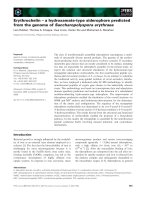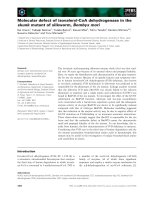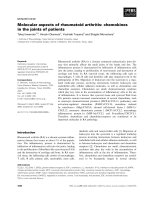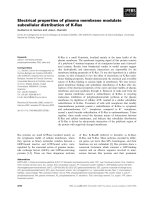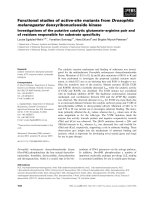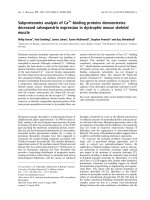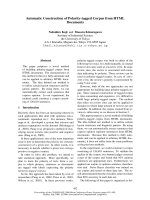Báo cáo khoa học: Channel-forming activities of peroxisomal membrane proteins from the yeast Saccharomyces cerevisiae pot
Bạn đang xem bản rút gọn của tài liệu. Xem và tải ngay bản đầy đủ của tài liệu tại đây (527.69 KB, 11 trang )
Channel-forming activities of peroxisomal membrane
proteins from the yeast Saccharomyces cerevisiae
Silke Grunau
1,2,
*, Sabrina Mindthoff
1,
*, Hanspeter Rottensteiner
1
, Raija T. Sormunen
3
,
J. Kalervo Hiltunen
2
, Ralf Erdmann
1
and Vasily D. Antonenkov
2
1 Institut fu
¨
r Physiologische Chemie, Abt. Systembiochemie, Bochum, Germany
2 Department of Biochemistry and Biocenter Oulu, University of Oulu, Finland
3 Department of Pathology, University of Oulu, Finland
Peroxisomes are ubiquitous subcellular organelles
involved in diverse metabolic activities, ranging from
the oxidation of fatty acids, purines, hydroxyacids,
alcohols and polyamines to the synthesis of plasmalo-
gens, ketone bodies and bile acids [1,2]. The protein
composition of peroxisomes depends on both the spe-
cies and environmental conditions. For example, the
peroxisomes from fungi and plants, but not from
mammals, contain enzymes of the glyoxylate cycle that
allow the conversion of acetyl-CoA molecules gener-
ated mainly by peroxisomal b-oxidation of fatty acids
into succinate, which can be used in a variety of reac-
tions, including the biosynthesis of amino acids or
carbohydrates [3].
A role for peroxisomal membrane as a permeability
barrier to solutes has been a matter of debate for more
than 40 years. Only recently was a ‘consensus’ reached
on the idea that this membrane is impermeable to
bulky solutes such as ATP and the cofactors,
NAD ⁄ H ⁄ , NADP ⁄ H ⁄ , CoA and its acyl derivatives
[1,4,5]. By contrast, the permeability of the membrane
to small solutes, including inorganic ions and organic
metabolites, is still a matter of controversy [1,4,5]. For
example, contradictory results were obtained concern-
ing the existence of pH [6,7] or Ca
2+
[8,9] gradients
across the peroxisomal membrane. Moreover, the
assumption that the presence of such gradients con-
firms the impermeability of the peroxisomal membrane
has recently been challenged [5]. Our previous studies
on mammalian peroxisomes showed that the mem-
brane of these particles is permeable to small solutes
[10] and contains pore-forming proteins [11]. Likewise,
Keywords
channels; membranes; peroxisomes;
Saccharomyces cerevisiae; yeast
Correspondence
V. D. Antonenkov, Department of
Biochemistry and Biocenter Oulu, University
of Oulu, Linnanmaa, PO Box 3000, FI-90014
Oulu, Finland
Fax: +358 8 5531141
Tel: +358 8 5531201
E-mail: vasily.antonenkov@oulu.fi
*These authors contributed equally to this
work
(Received 21 October 2008, revised
8 January 2009, accepted 12 January 2009)
doi:10.1111/j.1742-4658.2009.06903.x
Highly-purified peroxisomes from the yeast Saccharomyces cerevisiae grown
on oleic acid were investigated for the presence of channel (pore)-forming
proteins in the membrane of these organelles. Solubilized membrane pro-
teins were reconstituted in planar lipid bilayers and their pore-forming
activity was studied by means of multiple-channel monitoring or single-
channel analysis. Two abundant pore-forming activities were detected with
an average conductance of 0.2 and 0.6 nS in 1.0 m KCl, respectively. The
high-conductance pore (0.6 nS in 1.0 m KCl) is slightly selective to cations
(P
K+
⁄ P
Cl)
1.3) and showed an unusual flickering at elevated
(> ±40 mV) holding potentials directed upward relative to the open state
of the channel. The data obtained for the properties of the low-conduc-
tance pore (0.2 nS in 1.0 m KCl) support the notion that the high-conduc-
tance channel represents a cluster of two low-conductance pores. The
results lead to conclusion that the yeast peroxisomes contain membrane
pore-forming proteins that may aid the transfer of small solutes between
the peroxisomal lumen and cytoplasm.
Abbreviation
VDAC, voltage-dependent anion channel.
1698 FEBS Journal 276 (2009) 1698–1708 ª 2009 The Authors Journal compilation ª 2009 FEBS
channel-forming activity with properties of substrate-
specific pores has been reported for plant peroxisomes
[12,13].
A study on yeast is beneficial due to its simplicity
with respect to genetic manipulations. Yeast Saccharo-
myces cerevisiae grown on oleic acid contains
well-developed peroxisomes involved mainly in the
b-oxidation of fatty acids [14]. In the present study, we
report on the discovery and characterization of pore-
forming proteins in the peroxisomal membrane from
baker’s yeast, which were detected by an electrophysio-
logical study of peroxisomal proteins reconstituted into
artificial membranes.
Results
Characterization of yeast peroxisomal fraction
Peroxisomes were isolated from oleic acid-grown S. ce-
revisiae by Optiprep density centrifugation of freshly
prepared post-nuclear supernatants. The purity of per-
oxisomes collected from the bottom of the gradient
(fractions 3–4; Fig. 1A,B) was estimated by analysis of
the activity of marker enzymes for different organelles:
peroxisomes (catalase), mitochondria (cytochrome c
oxidase) and lysosomes (acid phosphatase) (Fig. 1A),
as well as by immunoblotting using antibodies gener-
ated against marker proteins for peroxisomal mem-
brane (Pex11p), mitochondrial outer membrane
(voltage-dependent anion channel; VDAC), endoplas-
mic reticulum (Kar 2p) (Fig. 1B) and membranes of
vacuoles (alkaline phosphatase) (data not shown). The
peroxisomes were well separated from the other cellu-
lar organelles, including mitochondria that may be a
main potential source of contaminating channel-form-
ing activities [15], and the purity was confirmed by
electron microscopic examination (Fig. 1C, panels 1
and 2). The images obtained demonstrate that the frac-
tion almost exclusively consists of peroxisomes. Most
of them were filled with matrix of variable electron
density, whereas, in some particles, only the membrane
was visible, indicating damage of peroxisomes during
isolation. On some occasions, an electron dense mate-
rial that was not surrounded by a membrane was
detected (Fig. 1C, panel 1). Apparently, this material
represents aggregates of peroxisomal matrix proteins
escaping from the particles.
To study the pore-forming activity, only peroxi-
somal fractions were used that contained less than
0.3% of the total cytochrome c oxidase activity loaded
on the gradient and that showed no traces of the mar-
ker proteins for different organelles on immunoblots
under standard assay conditions (Fig. 1B). For control
experiments (see below), the mitochondrial fraction
was selected from the same gradients (fractions 14–16;
Fig. 1A). As judged from the analysis of the distribu-
tion of markers for different organelles (Fig. 1A,B)
and data from electron microscopy (Fig. 1C, panel 3),
this fraction not only contained mitochondria, but also
membranes of other organelles, including endoplasmic
reticulum, vacuoles and peroxisomes.
Latency of yeast peroxisomal enzymes
To determine whether or not the yeast peroxisomal
membrane is permeable to solutes, we measured the
latency of some enzymes confined to the particles
(Fig. 2A). The activity of these enzymes was detected
in the isolated peroxisomal fraction before (‘free’ activ-
ity) and then after disruption of the membrane by
detergent (‘total’ activity; for details, see Experimental
procedures). Only 35% of the ‘total’ catalase activity
was registered in the absence of detergent. The latency
of catalase is a well known phenomenon that has been
attributed to the very high concentration in peroxi-
somes of this extremely active enzyme [16]. Similar to
catalase, the activities of cofactor-dependent peroxi-
somal enzymes (i.e. NAD-dependent malate dehydro-
genase, citrate synthase and malate synthase) were
found to be latent, indicating that at least one of the
cosubstrates ⁄ cofactors involved in the enzymatic reac-
tions is unable to freely traverse the peroxisomal mem-
brane. By contrast, detection under similar conditions
of an aspartate aminotransferase reaction showed that
the ‘total’ and ‘free’ activities of the enzyme were
almost equal (Fig. 2A). Importantly, the latter enzyme
does not require addition into the reaction medium of
any cofactor or other bulky solute. The data of the
latency determination support the notion that, similar
to the mammalian peroxisomal membrane [10], the
membrane of yeast peroxisomes provides free access to
the particles for small solutes but prevents diffusion of
bulky solutes such as cofactors (NAD ⁄ H ⁄ , NADP ⁄ H ⁄ ,
CoA and its acylated derivatives) and ATP [5]. Such
an arrangement of the barrier function of the yeast
peroxisomal membrane predicts that it contains pore-
forming proteins that allow the free diffusion of small
solutes.
The channel-forming activity in yeast
peroxisomes
To detect the predicted channel-forming activity of
purified peroxisomal preparations, we applied a
multiple-channel recording procedure that allows
estimation of the number and conductance of the
S. Grunau et al. Channels in yeast peroxisomal membrane
FEBS Journal 276 (2009) 1698–1708 ª 2009 The Authors Journal compilation ª 2009 FEBS 1699
single-channel events registered. Indeed, the proteins
solubilized from purified yeast peroxisomes were able
to form membrane pores (Fig. 2B) displaying two
predominant types of the channel-forming activity,
with an average conductance of 0.2 and 0.6 nS in
1.0 m KCl (Fig. 2C, upper panel). The pattern of the
conductance distribution differed significantly from
that detected in the mitochondrial fraction (compare
the upper and lower panels in Fig. 2C), indicating
that the pore-forming activity is determined by perox-
isomal proteins but not by contaminating proteins
from other organelles.
Fig. 1. Purification of peroxisomes from oleate-grown yeast S. cerevisiae. Organelles from a post-nuclear supernatant were separated by
Optiprep density gradient centrifugation and organelle segregation was monitored by (A) enzyme measurements and (B) immunoblot analy-
sis of marker proteins. (A) Fractions from the linear Optiprep gradient were analyzed for marker enzyme activities: catalase (a, filled bars,
peroxisomes), cytochrome c oxidase (a, gray bars, mitochondria), acid phosphatase (b, filled bars, lysosomes) or protein content (b, gray
bars). The results obtained are expressed as the relative activity. Enzyme (protein) recoveries varied in the range 88–110%. The line connect-
ing small open squares (b) marks the density of the gradient. (B) Proteins from equal volumes (20 lL) of each fraction (fractions 1–8 and
22–28) or every second fraction (fractions 8–22) (Fig. 1A) were separated by SDS ⁄ PAGE and analyzed by an immunoblot technique using
antibodies against the organelle markers: Pex11p (peroxisomes), VDAC (mitochondria) and Kar2p (endoplasmic reticulum). (C) Electron micro-
graphs of subcellular organelles isolated by means of Optiprep gradient centrifugation. Gradient fractions enriched in peroxisomes (fractions
3–4; Fig. 1A,B) or mitochondria and other organelles (fractions 14–16) were combined and mixed with an equal volume of 2% (w ⁄ v) glutaral-
dehyde prepared on 40% (w ⁄ v) Optiprep solution to avoid osmotic damage of peroxisomes (for further details, see Experimental proce-
dures). After overnight fixation, the organelles were sedimented and processed for electron microscopy. Panels 1 and 2: isolated
peroxisomes at lower (1) and higher (2) magnifications, scale bars = 1000 and 200 nm, respectively; panel 3: mitochondrial fraction, scale
bar = 2000 nm. Amorphous electron-dense material that might indicate aggregates of escaped peroxisomal matrix proteins is marked by an
asterisk in (C, panel 1).
Channels in yeast peroxisomal membrane S. Grunau et al.
1700 FEBS Journal 276 (2009) 1698–1708 ª 2009 The Authors Journal compilation ª 2009 FEBS
Next, we investigated the subperoxisomal localiza-
tion of the channel-forming activities. Peroxisomal
matrix proteins were separated from membrane
fragments by centrifugation in sucrose gradients after
organelle disruption by sonication. When proteins sol-
ubilized from the isolated membrane fragments were
analysed for channel-forming activity, a conductance
pattern analogous to that of the whole peroxisomal
preparations was obtained (data not shown). By
contrast, the matrix proteins did not show any pore-
forming activity. The conductance pattern of the per-
oxisomal channels was not affected by a shift in pH of
the bath solution from pH 6.0 (unbuffered 1.0 m KCl)
to pH 7.6 or pH 8.4 by adding 20 mm (final concentra-
tion) Mops or Tris buffers, respectively, or by preincu-
bation of protein preparations with dithiothreitol
(5 mm, final concentration, data not shown). The later
finding may indicate that the redox state of SH groups
in molecules of the channel-forming protein(s) does
not affect the activity of these proteins significantly.
As expected for large water-filled channels, the single-
channel conductance registered by multiple-channel
recording increased almost linearly with an increasing
KCl concentration (Fig. 2D). According to our data,
the peroxisomal pore-forming proteins were active not
only with KCl as an electrolyte, but also activity was
detected with other small ions that were tested at a
concentration of 1.0 m (pH 6.8): NH
4
Cl, LiCl, potas-
sium acetate and sodium phosphate. However, we were
unable to register any activity with some larger electro-
lytes [e.g. tetraethylammonium chloride (1.0 m)or
AMP (0.25 m potassium salt, pH 6.8)], although the
activity with these ions was evidently present in frac-
tions enriched with mitochondria.
Electrophysiological properties of a
high-conductance channel
We used a single-channel analysis to describe proper-
ties of the peroxisomal membrane channel with an
Fig. 2. Latency of peroxisomal enzymes
and multiple-channel monitoring of the pore-
forming activity in yeast peroxisomes. (A)
‘Free’ activity of yeast peroxisomal enzymes
presented as a percentage of the ‘total’
activity detected after incubation of purified
peroxisomes with 0.1% (w ⁄ v, final concen-
tration) Triton X-100. (B) Traces of the
multiple-channel monitoring of an artificial
membrane in the presence of detergent-
solubilized peroxisomes (upper panel) or
mitochondria (lower panel). The trace in the
frame (upper panel) shows a timescale-
expanded current recording of the upper
trace. The bath solution contained 1
M KCl
on the both sides of the membrane. The
temperature was +20 °C and the applied
voltage was +20 mV. (C) Histograms of
insertion events observed during multiple-
channel monitoring (B) in the presence of
purified detergent-solubilized peroxisomes
(upper panel; combined gradient fractions 3
and 4; see Fig. 1A) or fraction-enriched in
mitochondria and other organelles (lower
panel; combined gradient fractions 14–16;
see Fig. 1A). The total number of insertion
events was 180–200 for each membrane
preparation analyzed. Each experiment was
repeated three times; typical histograms are
presented. (D) Channel conductance as a
function of KCl concentration. The data for
high-conductance activity ( 0.6 nS in 1.0
M
KCl; see Fig. 2C) are shown. The
mean ± SD conductance for 30–40 single
insertion events was calculated.
S. Grunau et al. Channels in yeast peroxisomal membrane
FEBS Journal 276 (2009) 1698–1708 ª 2009 The Authors Journal compilation ª 2009 FEBS 1701
average conductance of 0.6 nS in 1.0 m KCl (see
above). Figure 3A displays the current recordings at
holding potentials +20, +60 and )60 mV and an
equal concentration of electrolyte (1.0 m KCl) on both
sides of an artificial membrane, being characteristic of
an ion channel with a slope conductance of
K = 0.68 ± 0.4 nS (n = 6). The channel inserted in
the membrane was mainly fully open during the whole
period of activity registration (minutes) at a wide range
of holding potentials (from )80 to +80 mV). The
channel showed strong flickering that was directed
upwards (at positive voltages), especially at higher
holding potentials. This flickering was detected in all
twenty measurements. The direct transition of some
spikes down to the fully-closed state of the channel
was observed (Fig. 3A, lower trace in the right panel),
indicating that the current transitions are substates of
a single channel rather than amplitudes of several inde-
pendent channels inserted in the membrane. The flick-
ering of the channel resembles the behaviour of the
CLC-0 chloride channel consisting of two pore-form-
ing protein molecules [17] (for details, see Discussion).
This may indicate that, similar to the CLC-0 channel,
the peroxisomal channel represents a cluster of pore-
forming proteins in which only one is in a permanently
open state, whereas others display a fast, transient
gating. The nature of this gating deserves further
investigation.
The reversal potential of a single channel
(Fig. 3B,C) under asymmetric salt conditions (1.0 m
Fig. 3. Single-channel analysis of the high-
conductance channel. (A) Current traces of
a bilayer containing a single high-conduc-
tance pore-forming protein (the insertion
event is marked by asterisk) at different
membrane potentials (1.0
M KCl on both
sides of the membrane). Applied membrane
potentials are indicated. Note that the chan-
nel displayed an intensive flickering at +60
and )60 mV, respectively. The largest cur-
rent amplitude of this flickering is approxi-
mately threefold higher than the amplitude
of the channel itself. The lower trace in the
right panel shows the direct transition of
one of the spikes down to the fully-closed
state of the channel (marked by arrowhead).
(B) Current traces of a bilayer containing
one high-conductance channel (the insertion
event is marked by asterisk) under asym-
metric salt conditions: 1.0
M KCl cis ⁄ 0.5 M
KCl trans compartment. Control experi-
ments demonstrated that, after adjustment
of the electrolyte concentration on both
sides of the membrane to 1.0
M KCl, the
channel displayed a current amplitude of
12–15 pA at +20 mV, which reflects the
conductance detected in the multiple-chan-
nel recording experiments (Fig. 2C). (C)
Current–voltage relationship of the high-con-
ductance channel under asymmetric salt
concentrations (see Fig. 3B); data points are
mean ± SD of at least six independent
measurements.
Channels in yeast peroxisomal membrane S. Grunau et al.
1702 FEBS Journal 276 (2009) 1698–1708 ª 2009 The Authors Journal compilation ª 2009 FEBS
KCl cis ⁄ 0.5 m KCl trans compartment) was
E
rev
= +2.0 mV, indicating that the channel has a
slight preference for cations over anions
(P
K+
⁄ P
Cl)
= 1.3). The slope conductance of the
channel was K = 0.95 nS (in 1.0 m ⁄ 0.5 m KCl). As
with symmetric salt conditions, the channel displayed
high-conductance flickering, especially at negative
holding potentials (Fig. 3B).
Single-channel analysis of a low-conductance
channel
More than 80 insertion events were detected in the sin-
gle-channel analysis experiments. Approximately 60%
of the inserted channels showed properties of the
high-conductance channel (0.6 nS in 1.0 m KCl; see
previous section). The second largest group of inser-
Fig. 4. Single-channel analysis of the low-conductance channel. (A) Upper panel: current trace of the channel (the insertion event is marked
by asterisk). The bath solution (A–D) comprised 1.0
M KCl on both sides of the membrane. Lower panel: current trace of the low-conduc-
tance channel in response to voltage ramp protocol (from )100 to 100 mV, 10 s). (B) Current trace of the low-conductance channel under-
going transition to the high-conductance channel. Upper panel: direct transition of the channel-forming activity between the closed state and
the fully-open state (marked by asterisk) and between the fully-open state and the intermediate state (marked by an arrowhead). The inter-
mediate state corresponds to the low-conductance channel activity. Lower panel: current trace of the same channel as that shown in the
upper panel but at a higher holding potential. The fully-closed state of the channel (marked by an asterisk) side by side with the spikes of
the flickering (marked by arrowheads) is visible. (C) Upper panel: current trace showing two sub-conductance states with almost equal ampli-
tude; each of these states represents the amplitude of the low-conductance channel. Lower panel: count rate histogram of the upper current
trace. (D) Upper panel: current trace of the super-large conductance channel with current amplitude in the fully open state 130 pA (1.0
M
KCl, +20 mV). Lower panel: a timescale-expanded current recording of the part shown in the frame in the upper trace. Note the direct transi-
tion from the closed to the fully-open state and the short lifetime of the open state. The partial closure of the channel leads to the appear-
ance of a stable substate with a current amplitude comprising one-third of the amplitude characteristic of the fully-open channel.
S. Grunau et al. Channels in yeast peroxisomal membrane
FEBS Journal 276 (2009) 1698–1708 ª 2009 The Authors Journal compilation ª 2009 FEBS 1703
tion events (Fig. 4A) displayed a conductance similar
to that of the low-conductance channel activity
detected by multiple-channel monitoring (i.e. 0.2–
0.3 nS in 1.0 m KCl; see above). The current–voltage
relationship measured for these channels revealed a
slope conductance of K = 0.28 nS (1.0 m KCl on both
sides of the membrane; data not shown). Recording of
the activity at elevated holding potentials showed an
upward flickering (at positive potentials) with different
open channel amplitudes (Fig. 4A,B, lower panels).
The flickering that was upward relative to the open
state of the main channel (at positive potentials)
resembled the similar behaviour of the high-conduc-
tance channel (for comparison, see Fig. 3A,B). The
reversal potential of the low-conductance channel in
asymmetric KCl solutions (1.0 m KCl cis ⁄ 0.5 m KCl
trans compartment) was E
rev
= +2.4 mV (data not
shown), which is close to the result obtained for the
high-conductance channel (E
rev
= 2.0 mV). Therefore,
it appears that the ion selectivity of low- and high-con-
ductance channels is almost identical. Approximately
half of the low-conductance traces displayed multiple
transitions to the level with higher current amplitudes
(Fig. 4B,C), which approximately corresponded to the
amplitude of the high-conductance channel under the
same experimental conditions. The smaller current
amplitude reached approximately one half of the full
conductance (Fig. 4C). Direct transitions from the
closed to the fully-open state (largest current ampli-
tude), and from the closed state to the intermediate
state (smaller amplitude), were observed (Fig. 4B). The
partially open state was also approached from the
fully-open state (Fig. 4B,C). These observations indi-
cate that the intermediate amplitude is a substate of a
single-channel molecule inserted in the membrane,
rather than amplitudes of two independently active
channel molecules. Taken together, the data obtained
in the single-channel analysis lead to the suggestion
that the high-conductance channel may represent a
cluster of two low-conductance channels (for details,
see Discussion).
The selectivity of the channel-forming activities
towards cations (see above), which is opposite to ion-
selectivity of the VDAC at low holding potentials
[18,19], provided an additional opportunity to assess
whether the activities described in the present study
are truly peroxisomal or determined by mitochondrial
contamination. Therefore, using single-channel analy-
sis, we compared ion-selectivity of the channel-forming
proteins from peroxisomal and mitochondrial frac-
tions, respectively. At asymmetric salt conditions
(1.0 m KCl cis ⁄ 0.5 m KCl trans compartment) and
zero holding potential, all 56 inserted channels dis-
played selectivity towards cations when the peroxi-
somal fraction was used in the experiments. However,
when measurements were made on the mitochondrial
fraction, only 19 out of 48 inserted channels showed
cation selectivity, whereas the other channels were
selective towards anions. These results strongly support
our conclusion that peroxisomes from baker’s yeast
contain cation-selective channel-forming protein.
On several occasions, the channel activities regis-
tered in the peroxisomal fraction showed very large
current amplitudes (Fig. 4D). The channels with cur-
rent amplitudes in a fully-open state of 30, 60 and
130 pA (1.0 m KCl, +20 mV) were registered. They
displayed strong downward (relative to the open
states) flickering, indicating closure of the channels.
The average mean lifetime of the fully-open channels
was relatively low (s
open
< 100 ms). Properties of the
‘super-large’ conductance channels (Fig. 4D) were not
analysed further because of their low abundance.
Discussion
The results of the present study demonstrate that the
membrane of peroxisomes from the yeast S. cerevisiae
contains channel ⁄ pore-forming proteins, as concluded
from the following data: (a) proteins solubilized from
highly-purified peroxisomal preparations showed an
abundant channel-forming activity in the multiple-
channel recording experiments, the pattern of which is
completely different from that of the mitochondrial
fraction; (b) the channel-forming activity was shown to
associate with membrane proteins of peroxisomes; and
(c) the results of the single-channel analysis experi-
ments revealed that, in regard to single-channel con-
ductance, ion-selectivity and voltage-dependence, the
investigated peroxisomal channels was found to be dis-
tinctly different from VDAC of the outer mitochon-
drial membrane [18,19], which can be expected as a
major source of the channel-forming activity contami-
nation in the peroxisomal preparations.
Our finding regarding channel-forming activity in
the yeast peroxisomal membrane is consistent with pre-
vious observations describing such activity in plants
[12,13] and mammals [11]. In addition, the 31 kDa
protein isolated from peroxisomal preparations of the
yeast Hansenula polymorpha showed channel-forming
properties [20]. However, further characterization of
this protein revealed properties similar to mitochon-
drial VDAC [20]. An electrophysiological analysis of
the channel-forming activity related to the 31 kDa
protein has not been described. Therefore, it is unclear
whether this protein represents a peroxisomal consti-
tuent or a mitochondrial contamination.
Channels in yeast peroxisomal membrane S. Grunau et al.
1704 FEBS Journal 276 (2009) 1698–1708 ª 2009 The Authors Journal compilation ª 2009 FEBS
The peroxisomal channels from different sources
share features characteristic of bacterial and mamma-
lian porins monitored by the planar lipid bilayer tech-
nique: (a) the pores remain open for a prolonged
period of time (seconds to minutes); (b) the conduc-
tance of the channels is relatively large (> 0.2 nS in
1.0 m KCl); and (c) there is a total absence or weak
voltage-dependence of channel gating. Interestingly,
according to our preliminary data (unpublished
results), the diameter of the peroxisomal channel is
rather small (< 0.6 nm) and, in this sense, the channel
shows similarity to the plant peroxisomal porin [12,13].
However, in contrast to the plant protein, which
displays strong anion selectivity and weak voltage
dependence, the yeast peroxisomal channel is slightly
cation-selective and not voltage-gated. The plant per-
oxisomal channel, similar to some porins from the
outer bacterial membranes [21], can be considered as a
specific porin that preferably allows passing through of
mono- and dicarboxylic acids [13]. Whether the yeast
peroxisomal channels show similar properties is
currently under investigation.
The conductance pattern of the plant peroxisomal
channel detected by the multiple channel recording at
+20 mV using 1.0 m KCl as an electrolyte reveals
two main conductance levels: 0.3 and 0.6 nS, respec-
tively [12], which is very close to the pattern
described in the present study (Fig. 2B,C). These
results can be explained by both plant and yeast
high-conductance channels functioning as dimers con-
sisting of two low-conductance channels. This notion
was substantiated by the single-channel analysis
experiments. The cluster organization is not a unique
feature of the peroxisomal pore-forming proteins.
Some other examples are trimeric organization of
bacterial porins [21] and the dimeric structure of the
CLC chloride channels [17]. The latter shares an unu-
sual behavior of the yeast peroxisomal channels: an
upward flickering relative to the main open state (at
positive holding potentials) representing fast-gating
transitions. The lifetime in the fully-open state of the
dimer of the monomeric subunits of the chloride
channel is not the same; usually, it is much longer
than that for one of the monomers [17]. The fast gat-
ing of one monomer produces an upward flickering
relative to the baseline, which is determined by the
fully-open state of the counterpart channel. This
might comprise one of the mechanistic explanations
for the ‘upward’ flickering of the yeast peroxisomal
channels. The proposed mechanism leads to the pre-
diction that the channel is organized in complex clus-
ters containing a dozen, or even more, monomeric
subunits. However, at present, we cannot exclude the
possibility of other mechanisms that might lead to
the ‘upward’ flickering of the channels.
The functional role of the yeast peroxisomal channels
remains to be established. Presumably, the channels
form a general diffusion pore in the membrane and
function as a size-selective filter that allows crossing of
the membrane by a wide variety of small solutes, but
prevents transfer of ‘bulky’ compounds, including ATP
and cofactors (NAD ⁄ H, NADP ⁄ H and CoA). The
channels may provide a route to transfer metabolites
such as carnitine or di- and tricarboxilic acids, which
participate in the peroxisomal b-oxidation of fatty acids
and the glyoxylate cycle, respectively. They are also
apparently involved in shuttle mechanisms required for
metabolic conversion of peroxisomal cofactors [22]. Our
preliminary data suggest that some peroxisomal metab-
olites may be transferred by a so-called ‘specific’ chan-
nel. This type of channel is characteristic of the outer
membrane of Gram-negative bacteria [21]. Therefore,
the overall functional organization of the yeast peroxi-
somal membrane transport system may be similar to
that of the outer membrane of bacteria.
Experimental procedures
Strains, media and culture conditions
The yeast strain used in the study was S. cerevisiae UTL7-A
(MATa leu2-3, 112 ura3-52 trp1) [23]. Yeast cells were
grown under aerobic conditions on YNDO [0.1% (w ⁄ v)
yeast extract, 0.67% (w ⁄ v) yeast nitrogen base without
amino acids, 0.1% (w ⁄ v) oleic acid, 0.1% (w ⁄ v) glucose,
0.05% (v ⁄ v) Tween 40] medium at pH 6.0 [23].
Isolation of peroxisomes
Preparation of yeast spheroplasts, cell homogenization and
isolation of a postnuclear supernatant were performed as
described previously [23]. Peroxisomes (10 mg of protein)
were isolated using a preformed linear 2.25–24.0% (w ⁄ v)
Optiprep (Iodixanol; Axis-shield PoC AS, Oslo, Norway)
density gradient. The gradients were centrifuged in a verti-
cal rotor (TV860; Sorvall; Thermo Fisher Scientific Inc.,
Waltham, MA, USA) at 48 000 g (maximum) for 1.5 h.
The fractions were collected from the bottom of the tubes
and used immediately for analysis of the activities of
marker enzymes for subcellular organelles.
Measurement of enzyme activities and latency
determination
Catalase and cytochrome c oxidase, marker enzymes for
peroxisomes and mitochondria, respectively, were detected
S. Grunau et al. Channels in yeast peroxisomal membrane
FEBS Journal 276 (2009) 1698–1708 ª 2009 The Authors Journal compilation ª 2009 FEBS 1705
as described previously [24]. Acid phosphatase was mea-
sured as marker for lysosomes [25]. Activities of NAD-
dependent malate dehydrogenase, citrate synthase and
malate synthase [26], and the activity of aspartate amino-
transferase [26,27], were measured in the purified peroxi-
somal fraction. Protein content was determined according
to the method of Bradford [27a].
The latency of peroxisomal enzymes was detected after
resedimentation of the particles in a two-step [20% (w ⁄ v)
and 50% (w ⁄ v) sucrose] gradient in a vertical rotor at
100 000 g (maximum) for 45 min. ‘Free’ enzyme activity
was measured prior to disruption of the peroxisomal mem-
brane by Triton X-100 [0.1% (w ⁄ v) final concentration] to
reveal the ‘total’ enzyme activity [10].
Antibodies and immunoblot analysis
Polyclonal rabbit antibodies were raised against Pex11p,
VDAC [28], Kar2p [29] and alkaline phosphatase (Molecu-
lar Probes, Leiden, The Netherlands) to detect the corre-
sponding marker proteins for different cellular organelles.
SDS ⁄ PAGE and immunoblotting were performed according
to standard procedures and blots were developed using the
ECL system (GE Healthcare, Chalfont, St Giles, UK).
Electron microscopy
For transmission electron microscopy, the isolated peroxi-
somes were fixed in 1% (w⁄ v) glutaraldehyde overnight at
4 °C. The organelles were sedimented at 20 000 g (maxi-
mum) for 30 min and processed as described previously [30].
Detection of the pore-forming activity
To study pore-forming activities of yeast peroxisomal pro-
teins, multiple-channel recording and single-channel analy-
sis of solubilized membrane proteins reconstituted into an
artificial lipid bilayer were applied. The peroxisomal frac-
tion collected from Optiprep gradients was diluted 10-fold
with 20 m m Mops buffer, pH 7.2 (0.02–0.04 mgÆmL
)1
protein) and treated with 0.5% (w ⁄ v, final concentration)
Genapol X-080 (Fluka, Buchs, Switzerland) by rotating for
1 h at 4 °C. After sedimentation of insoluble material at
100 000 g (maximum) for 45 min, the resulting supernatant
was immediately used for detection of the pore-forming
activity.
Multiple-channel recordings were performed as described
previously [31] in a Teflon chamber separated into two
compartments (5 mL each) by the wall containing a circular
hole (0.2 mm
2
). The lipid bilayer was formed across this
hole by the painting technique using 1% (w ⁄ v) diphytanoyl
phosphatidylcholine (Avanti Polar Lipids Inc., Alabaster,
AL, USA), dissolved in n-decane ⁄ butanol (9 : 1, v ⁄ v). After
formation of a stable membrane with a typical capacitance
of 400–700 pF, the solubilized membrane proteins (4 lL)
were added to both compartments of the chamber, which
were equipped with magnetic stirrers. One molar bath
solutions of KCl were used, unless otherwise stated. The
temperature was 20 °C. A Planar Lipid Bilayer Worksta-
tion equipped with a BC-535 amplifier and an 8 pole low-
pass Bessel filter (Warner Instruments, Hamden, CT, USA)
was used for the current detection. Acquisition and analysis
were performed using pCLAMP software (Axon Instru-
ments, Foster City, CA, USA). Membrane currents were
measured at a holding potential of +20 mV (unless other-
wise stated) with a pair of Ag ⁄ AgCl electrodes. The data
were filtered at 30 Hz and collected at 2.0 kHz. Multiple-
channel recording allows measurements of a large number
of insertion events of reconstituted pore-forming proteins,
as well as quantitative analysis of these activities by using
histograms of insertion frequency relative to current ampli-
tudes. For each histogram, the absolute number of insertion
events with a certain current amplitude (bin size = 2.0 pA)
was calculated.
For a more detailed investigation of the electrophysio-
logical properties of the pore-forming proteins, we used a
single-channel analysis, which allows characterization at
the high-time resolution of a single channel inserted in
the artificial membrane. Commercial chambers (Warner
Instruments) with two compartments (4 mL each) sepa-
rated by wall with a circular hole (0.04 mm
2
) were used.
The Ag ⁄ AgCl electrodes were connected to the compart-
ments via 2 m KCl-agar bridges. As in the case of multi-
ple-channel recordings, the electrode of the trans
compartment was directly connected to the headstage of a
current amplifier. Reported membrane potentials are
referred to the trans compartment. The capacitance of the
bilayer was in the range 70–90 pF. The data were filtered
at 1.0 kHz and collected at 2.0 kHz. Measurements of
reversal potentials were performed by establishing a two-
fold (1.0 m KCl cis ⁄ 0.5 m KCl trans compartment) salt
gradient after formation a stable lipid bilayer. After inser-
tion of a single channel, the current was initially recorded
at 0 mV and, subsequently, at different membrane poten-
tials. In a separate set of experiments, the number of
cation-selective versus anion-selective channels was calcu-
lated in peroxisomal and mitochondrial fractions, respec-
tively. Asymmetric salt conditions (1.0 m KCl cis ⁄ 0.5 m
KCl trans compartment) were used and each insertion
event was initially detected at zero holding potential fol-
lowed by application of a voltage ramp protocol (from
)40 to +40 mV, 10 s).
Acknowledgements
This work was supported by grants from the Academy
of Finland, Sigrid Juselius Foundation; the Deutsche
Forschungsgemeinschaft (ER 178 ⁄ 2-4); and the
Channels in yeast peroxisomal membrane S. Grunau et al.
1706 FEBS Journal 276 (2009) 1698–1708 ª 2009 The Authors Journal compilation ª 2009 FEBS
European Union Project ‘Peroxisomes’ (LSHG-CT-
2004-512018). We are grateful to Professor R. Benz
from the Lehrstuhl fur Biotechnologie, Universita
¨
t
Wurzburg, Germany, and Professor M. Weckstro
¨
m
from the Department of Physical Sciences, University
of Oulu, Finland, for helpful discussion.
References
1 Wanders RJ & Waterham HR (2006) Biochemistry of
mammalian peroxisomes revisited. Annu Rev Biochem
75, 295–332.
2 Poirier Y, Antonenkov VD, Glumoff T & Hiltunen JK
(2006) Peroxisomal beta-oxidation – a metabolic path-
way with multiple functions. Biochim Biophys Acta
1763, 1413–1426.
3 Kunze M, Pracharoenwattana I, Smith SM & Hartig
A (2006) A central role for the peroxisomal membrane
in glyoxylate cycle function. Biochim Biophys Acta
1763, 1441–1452.
4 Rottensteiner H & Theodoulou FL (2006) The ins and
outs of peroxisomes: co-ordination of membrane trans-
port and peroxisomal metabolism. Biochim Biophys
Acta 1763, 1527–1540.
5 Antonenkov VD & Hiltunen JK (2006) Peroxisomal
membrane permeability and solute transfer. Biochim
Biophys Acta 1763, 1697–1706.
6 Dansen TB, Wirtz KW, Wanders RJ & Pap EH (2000)
Peroxisomes in human fibroblasts have a basic pH.
Nat Cell Biol 2, 51–53.
7 Jankowski A, Kim JH, Collins RF, Daneman R,
Walton P & Grinstein S (2001) In situ measurements
of the pH of mammalian peroxisomes using the fluo-
rescent protein pHluorin. J Biol Chem 276, 48748–
48753.
8 Lasorsa FM, Pinton P, Palmieri L, Scarcia P, Rotten-
steiner H, Rizzuto R & Palmieri F (2008) Peroxisomes
as novel players in cell calcium homeostasis. J Biol
Chem 283, 15300–15308.
9 Drago I, Giacomello M, Pizzo P & Pozzan T (2008)
Calcium dynamics in the peroxisomal lumen of living
cells. J Biol Chem 283, 14384–14390.
10 Antonenkov VD, Sormunen RT & Hiltunen JK (2004)
The rat liver peroxisomal membrane forms a perme-
ability barrier for cofactors but not for small metabo-
lites in vitro. J Cell Sci 117, 5633–5642.
11 Antonenkov VD, Rokka A, Sormunen RT, Benz R &
Hiltunen JK (2005) Solute traffic across mammalian
peroxisomal membrane – single channel conductance
monitoring reveals pore-forming activities in peroxi-
somes. Cell Mol Life Sci 62, 2886–2895.
12 Reumann S, Maier E, Benz R & Heldt HW (1995)
The membrane of leaf peroxisomes contains a porin-
like channel. J Biol Chem 270, 17559–17565.
13 Reumann S, Maier E, Heldt HW & Benz R (1998)
Permeability properties of the porin of spinach leaf
peroxisomes. Eur J Biochem 251, 359–366.
14 Hiltunen JK, Mursula AM, Rottensteiner H, Wierenga
RK, Kastaniotis AJ & Gurvitz A (2003) The biochem-
istry of peroxisomal beta-oxidation in the yeast Sac-
charomyces cerevisiae . FEMS Microbiol Rev 27, 35–64.
15 O’Rourke B (2007) Mitochondrial ion channels. Annu
Rev Physiol 69, 19–49.
16 Baudhuin P (1969) Liver peroxisomes, cytology and
function. Ann N Y Acad Sci 168, 214–228.
17 Chen TY & Hwang TC (2008) CLC-0 and CFTR:
chloride channels evolved from transporters. Physiol
Rev 88, 351–387.
18 Benz R (1994) Permeation of hydrophilic molecules
through the outer membranes: review on mitochondrial
porins. Biochim Biophys Acta 1197, 167–196.
19 Ujwal R, Cascio D, Colletier J-P, Faham S, Zhang J,
Toro L, Ping P & Abramson J (2008) The crystal
structure of mouse VDAC1 at 2.3 A
˚
resolution reveals
mechanistic insights into metabolite gating. Proc Natl
Acad Sci USA 105, 17742–17747.
20 Sulter GJ, Verheyden K, Mannaerts G, Harder W &
Veenhuis M (1993) The in vitro permeability of yeast
peroxisomal membranes is caused by a 31 kDa integral
membrane protein. Yeast 9, 733–742.
21 Koebnik R, Locher KP & Van Gelder P (2000) Struc-
ture and function of bacterial outer membrane pro-
teins: barrels in a nutshell. Mol Microbiol 37, 239–253.
22 van Roermund CW, Elgersma Y, Singh N, Wanders
RJ & Tabak HF (1995) The membrane of peroxisomes
in Saccharomyces cerevisiae is impermeable to
NAD(H) and acetyl-CoA under in vivo conditions.
EMBO J 14, 3480–3486.
23 Erdmann R, Veenhuis M, Mertens D & Kunau WH
(1989) Isolation of peroxisome-deficient mutants of
Saccharomyces cerevisiae . Proc Natl Acad Sci USA 86,
5419–5423.
24 Leighton F, Poole B, Beaufay H, Baudhuin P, Coffey
JW, Fowler S & De Duve C (1968) The large-scale
separation of peroxisomes, mitochondria, and lyso-
somes from the livers of rats injected with triton
WR-1339. Improved isolation procedures, automated
analysis, biochemical and morphological properties of
fractions. J Cell Biol 37, 482–513.
25 Van Veldhoven PP, Baumgart E & Mannaerts GP
(1996) Iodixanol (Optiprep), an improved density gra-
dient medium for the iso-osmotic isolation of rat liver
peroxisomes. Anal Biochem 237, 17–23.
26 Cooper TG & Beevers H (1969) Beta-oxidation in gly-
oxysomes from castor bean endosperm. J Biol Chem
244, 3514–3520.
27 Verleur N, Elgersma Y, Van Roermund CW, Tabak
HF & Wanders RJ (1997) Cytosolic aspartate amino-
S. Grunau et al. Channels in yeast peroxisomal membrane
FEBS Journal 276 (2009) 1698–1708 ª 2009 The Authors Journal compilation ª 2009 FEBS 1707
transferase encoded by the AAT2 gene is targeted to
the peroxisomes in oleate-grown Saccharomyces cerevi-
siae. Eur J Biochem 247, 972–980.
27a Bradford MM (1976) A rapid and sensitive method
for the quantitation of microgram quantities of protein
utilizing the principle of protein-dye binding. Anal
Biochem 72, 248–254.
28 Kerssen D, Hambruch E, Klaas W, Platta HW,
de Kruijff B, Erdmann R, Kunau WH & Schliebs W
(2006) Membrane association of the cycling peroxisome
import receptor Pex5p. J Biol Chem 281, 27003–27015.
29 Rose MD, Misra LM & Vogel JP (1989) KAR2, a
karyogamy gene, is the yeast homolog of the mamma-
lian BiP ⁄ GRP78 gene. Cell 57, 1211–1221.
30 Antonenkov VD, Sormunen RT & Hiltunen JK (2004)
The behavior of peroxisomes in vitro: mammalian
peroxisomes are osmotically sensitive particles. Am J
Physiol Cell Physiol 287, C1623–C1635.
31 Ludwig O, De Pinto V, Palmieri F & Benz R (1986)
Pore formation by the mitochondrial porin of rat brain
in lipid bilayer membranes. Biochim Biophys Acta 860,
268–276.
Channels in yeast peroxisomal membrane S. Grunau et al.
1708 FEBS Journal 276 (2009) 1698–1708 ª 2009 The Authors Journal compilation ª 2009 FEBS

